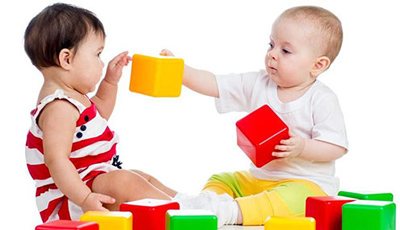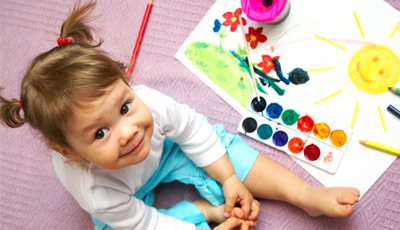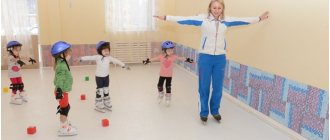Colors and ages
A newborn baby perceives the world around him as a large motley spot. From about the second month of life, the baby begins to distinguish yellow, orange, blue, green, black and white, and by six months - purple. We are talking about discrimination, recognition. The child cannot yet name this or that color or group toys and pictures according to this characteristic. During early childhood (from 1 to 3 years), the child is oriented in the spectrum, but colors do not yet act as essential features by which objects are identified. A child from 3 to 7 years old can distinguish and name colors, shades (light green, light brown, etc.), choose pencils, paints, felt-tip pens for drawing, coloring, cubes for constructing a building, parts for creating images from a construction set. The boundaries of the designated periods for the formation of color discrimination in a child are unclear and can vary depending on the individual characteristics of the baby and the conditions of his upbringing. Thus, a baby can be taught to distinguish colors already in infancy. Here are some ways to learn.
Showing and naming
Demonstration of an object followed by naming it is the main methodological technique for working with an infant child. For this activity you will need rattles. Shake the toy in the baby’s field of vision, saying: “Listen to the sound of the red rattle: “ding-ding”.” When working with a two-month-old baby, take one yellow rattle and change it after 2-3 days. Invite your baby to listen to red, green, and blue rattles. Gradually, the baby will learn to distinguish not only colors, but also sounds. When communicating with a 3-4 month old baby, use several sounding toys at once, shake them in turn, naming colors. A five-month-old baby can play with a rattle on his own. This will teach him to distinguish one toy from another, including by color. For a six-month-old baby, show pyramid rings and cubes and tell them their colors. Take the baby in your arms, carry him around the room or yard, showing and naming tables, chairs, wallpaper, clocks on the wall, slides, swings, horizontal bars, sandbox on the playground, grass, trees, not forgetting to talk about color. Since there are many colors in the world, separate the name of the color from the thing, say not “This is a blue swing,” but “This is a swing, they are blue.” Introduce a six-month-old baby to objects that are identical in appearance, but differently colored: “This ring is red, and this is blue.”
Cooperation

For the little ones in the second half of their life, showing and naming is no longer enough. It is important for the child to assemble the pyramid, practice with inserts, cubes, and try to lay out the “Vanka-Vstanka”. Show your child examples of actions, so he will quickly begin to distinguish objects by color. Pay close attention to the baby's safety. A one-year-old baby strives to see, touch, and examine everything that comes his way. Use this desire to introduce your child to different colors: “Let’s put a red cube on a blue one, we’ll get a tower,” “First we’ll string a yellow ring onto the pyramid pin, then a green one.” Combine teaching color discrimination with your baby's walking exercises. Place the bricks from the construction set in different places in the room and invite the child to approach each of them: “Let's go along the path to the yellow brick,” “Let's go along the path to the blue brick,” etc.
learning colors lesson plan on the topic
For you, parents!
Games and exercises to familiarize children with colors
Color pair recognition game. Take two boxes and cover them with colored paper. One is blue, the other is yellow. Or one - red, the other - green. Collect figures of the same colors from a construction set, balls, etc. Show your child what he should do and comment on his actions without naming colors. Say something like: “Let’s put these figures in this box, and these figures in this box.” If the child figures it out and names the colors correctly, reward him. If he doesn’t name it, don’t demand it from him. Let him do the exercise without naming colors. This way you will teach your child to find objects of the same color, comparing them with each other not yet on a conceptual level, but only visually. It is this experience that is primary, so repeat this exercise in different forms. Teach your child to compare and find objects of the same color, arrange them, combine them, etc. When your baby masters playing with two colors, take 3, then 4.
“Seven-colored”, frames and inserts made of soft polymer, in which primary colors are used, books, in which pictures of the same color are placed on each page.
Try to name colors more in everyday life. For example, say every time you give your baby his favorite mug, what color it is, like: “Here, have your favorite green mug,” or when your baby puts on his usual pants, emphasize what color they are. I can offer another idea: buy napkins the same color as your plates. Set the table with your child, saying that today you will have a particularly beautiful table because you will take napkins the same color as the plates. Give your baby one napkin (or plate) of the wrong color. When your child sets the table with you, he will notice the mistake. Correct the error together with your child.
Take a mosaic or counting sticks and, together with your child, place them on plates of the corresponding colors. Do not leave your child alone to play with small objects.
Find the same one"
Show your child one cube (red, yellow, green or blue) and ask him to bring the same one. Be sure to comment on your actions. If the child is at a loss, be sure to help him.
"Remove the extra one"
Lay out a path from blue cubes. But among them, place one red cube. Ask your child to find the extra cube.
"Game with your own hands"
We buy two sets of cardboard and start imagining. You can cut out flowers and butterflies. The child must plant butterflies on a flower of the same color. Or cut out cups and saucers and set the table - match each cup with a saucer of the same color.
"Little Athlete"
You can cut out large circles from cardboard, place them around the room and let the child run or jump from red to blue, from green to yellow, etc.
"Game with a pyramid"
When assembling and disassembling the pyramid, let the child name the colors of its rings.
The next day, prepare painted towels for your child, leaving the centers empty. From paper, cut out centers that match the color of the towels!
Draw a tree. You need to cut out leaves of different colors from colored paper and invite the child to glue all the yellow flowers onto the tree, then add green ones, and only then red ones!
Prepare the following: draw a palette of colors. The child’s task is to color the paint containers one by one, pronouncing the colors.
The things are torn, what can I do? We need to choose patches of appropriate colors for them!
Draw different things, paint a few of them one color, a few others with a different color. The child’s task is to connect these things together using the same color pencil with which they were painted.
Draw a large leaf, and also prepare several ladybugs of different colors. Invite your child to immediately attach yellow bugs to a leaf, then red ones, and so on.
Beads for mom! Draw several strings of beads, color each first one with any color. The child should paint the rest of the thread with the appropriate color.
Draw the outlines of vegetables and fruits on a piece of paper. The child's task is to color them with the appropriate colors!
I wish you success and fun time with your children.
A game
Children begin to play at about two years of age. A child rocks a doll or a bear, feeds them, and rides them on a toy car. Thinking about how to teach your child to recognize colors? Get involved in the game, focus your child’s attention on the colors of toys, doll clothes, dishes, furniture: “The bunny will drink tea from a red cup, and the bear from a blue one,” “We will dress the Masha doll in a yellow dress, and the Katya doll in a green one.” The problem of how to teach a child to distinguish colors worries not only parents, but also teachers. Specialists develop didactic (educational) games. Here is one of them (suitable for children 2-3 years old). Cut out the same number of squares with sides of 12 and 8 cm from colored cardboard. Glue an image of a mouse on a white background into the center of each large square. Invite your child to help the rodents hide in the “holes” from the cat. “Minks” are large squares. Small geometric shapes are “doors” that are needed to prevent the predator from detecting its prey. Use a small red square to cover the mouse on a large red square, a green one to cover a green one, etc. Ask your child to name the colors of “holes” and “doors.” The baby will gladly fulfill the request. A three-year-old child, together with his peers, will enjoy playing the active game “Colored Cars.” Prepare several multi-colored flags for yourself and paper circles - “rudders” for the kids. The color of the circle matches the color of a particular flag. Stand in the center of the site, and place the children outside it. You raise the flag, and the kids, holding a “steering wheel” of the same color in their hands, walk or run, imitating the movement of a passenger car. Games for children from 4 to 5 years old:
- “Arrange in order” (it is proposed to distribute pictures depicting, for example, oranges from the lightest to the darkest);
- “Seven-flowered” (the baby sequentially arranges the petals of the colors of the spectrum around the center of the flower);
- “Pick up a bouquet for the Snow Maiden and a ray of sunshine” (for the snow maiden choose paper flowers in cold shades, for a ray of sunshine - warm ones), etc.
The future schoolchild will be carried away by the games “Make a still life” (images selected according to the color scheme are superimposed on the silhouettes), “Name the colors of the seasons”, “Fold a pattern”, etc. Play with children, and the question of how to teach a child to distinguish colors will lose relevance .
Drawing
Children love to draw and begin to “create masterpieces” from about one year of age. At this time, the child draws arbitrary lines, strokes, rhythmically fills a sheet of paper with spots, not particularly caring about distinguishing between the colors of the palette. While the baby is busy drawing, comment on the child’s actions, name the colors: “What a wonderful red line!”, “What a beautiful yellow spot!”, suggest trying different colors: “Take green, let’s see what happens,” “And here it’s probably better.” blue." To help a two-year-old child navigate colors, use game exercises:
- add strings to the balls (draw the balls in advance, the child will add a thread of the same color as the ball);
- draw the rays of the sun and the rain from the cloud (draw the sun and the cloud on different sheets, the child will draw the rays in yellow, and the rain from the cloud in blue or purple);
- complete the petals (draw a few petals, the child will complete the image using the same colors), etc.
Children from 3 to 5 years old draw objects, elementary plots, and decorate the resulting work. While drawing, preschoolers' ideas expand. Kids use primary colors and shades, learn to distinguish between close and contrasting, warm and cold tones. The drawings of children from 5 to 7 years old are more complex. Preschoolers combine lines, colors, and drawing techniques. Here is another answer to the question of how to teach a child to distinguish colors. Draw with your baby more often. Under no circumstances leave your child alone with paints, brushes, or other painting supplies.
How to teach a child to distinguish colors?
The organs of vision have always been the main instrument for perceiving the world. And for a child under three years old, this is also an opportunity to develop and get acquainted with life in all its colors. By the way, I would like to focus special attention on the colors. The palette of colors and shades must not only be seen, but also be able to distinguish. At this moment, most mothers have a question: how to teach a child to remember colors? After all, a restless baby is interested in everything at once. This means that you again need to be patient and step by step show him how bright and colorful the world around him is. Today, teaching a child colors is not a problem at all. And we will not only prove this, but also give examples of interesting exercises.
Learning colors with a child
The first question we will touch on is when does a child begin to distinguish colors? Nature has endowed newborn babies with weak vision, or rather farsightedness. The baby begins to see objects and distinguish them from each other only 10 weeks after birth. The baby begins to confidently distinguish colors closer to six months. And he should know them by the age of 3-4 years. It is at this age that visual perception and touch are the leading ones among all senses. And if the baby does not yet know the name of this or that shade, you need to immediately start studying them. But before you start the exercises, it is important to understand that learning colors for children does not have to be a boring activity with endless memorization. The main activity of children is play. Especially if her mother joins her. When we study colors with a child, we try to captivate him with this process, but at the same time we should not impose a certain activity on him. Children quickly become distracted from one activity and switch to another. It is this age-related feature that must be relied upon when teaching.
How to teach a child colors?
You should start with red. Then comes yellow, green and blue. These colors are not only the main ones in the palette, but are also perceived by the child better than others. How to start training? Let's look at one example.
- Tell your child that today is red day. Hang a red balloon in a visible place or place red stickers everywhere. During the day, study only the color red;
- The best way to teach is through drawing. Children like this activity and will not be intrusive for them;
- Invite your child: “Let's take red paints (pencil, chalk, felt-tip pen, etc.) and draw a red house. I will draw the walls and the window, and you will draw the roof. Let you paint the roof red, and I’ll paint the house itself. What color do you paint the roof? Right. Red! What color should I make the walls? That's right, also red. Look what a wonderful red house we have!”;
- After the drawing is ready, hang it in a prominent place and show your family what a beautiful red house you have drawn.
How else to learn colors with your child? To prevent your baby from getting bored with the same activities, try different exercises with him:
- Cut out 4 triangles and 4 squares from cardboard of 4 colors. Swap the roofs and tell your child: “Oh, our houses have the roofs mixed up! Let's arrange them so that the colors match." Help your child identify the right house and name the colors.
- When you start doing laundry, invite your child to actively participate in this process. For example, you sort laundry by color, and your baby helps you determine the right shade. You can specially put something colored in white underwear. At the same time, ask your child: “Don’t you think that there is some kind of extra color here?” The same can be done when cleaning the house and sorting toys by color.
- Arrange a competition with your child to see who can find the most objects of the same color.
- You can start a game with one child or with several children at once to make it more fun for them. Cut out three large circles of red, green and yellow from cardboard. Explain the rules: when the color is red, you cannot move, when the color is yellow, you need to jump in place or on one leg, and if green appears, you can run. First, all actions are performed together with the child. Then you can silently show the cards or complicate the task and say the colors in your voice.
If you are wondering how to teach your child to distinguish colors and have already started studying, remember a few important rules:
- You can work with a child from 1.5 years old;
- do not start learning a new color until the baby has memorized the previous one;
- after the 4 primary colors, orange, purple, black and white should follow, and only then all other shades;
- do not rush the child and be sure to tell him if he has made a mistake. Introduce other colors into the game gradually. No more than two to start with;
- Do not use online games or other computer programs for learning. They will prevent the child from concentrating and ruin his vision.
Coloring

No less than drawing, children love to color. Involve your child in this activity from the age of two. In coloring books for kids, the images are large, the picture shows one object or character, and coloring samples are provided so that you can distinguish the details of the finished drawing. In coloring books for children from 4 to 5 years old there are not only subject, but also plot images: Marty the zebra rides dolphins, Carlson tells the Kid a secret, a boy and a girl hang a birdhouse. The child chooses the colors for coloring himself. Coloring books for 5-7 year old “artists” are supplemented with numbers, letters, and shading exercises. Coloring will be a good exercise in color discrimination if you invite the child to color numbers, letters, and make the image resulting from shading multi-colored. The baby will be interested in coloring, and parents will not have to worry about how to teach the child to distinguish colors.
Question
Hello!
My child is 4 and mixes up the colors. Maybe we just didn’t learn them or he’s colorblind. First I tell and show (white, yellow, red, green, blue, black), then I ask him to give me red, he gives it at random, and so on with all the colors, but I ask what color the sun is, show me yellow, but he can name at least red, green, or blue. And he’s left-handed and holds a pencil; he can’t draw well, I don’t know how to teach it. At home we start drawing, he can’t do it, he doesn’t try, then he gives up everything. Please, let’s start asking again, I want to eat and drink, and he’ll come up with something else. With simpler numbers, we learned up to 5 and count to ten (we always mix up seven and eight correctly). What should I do? He is starting to lag behind in development, and it will become even more difficult. But you can’t even say to be cunning, he’s learned to speak well, he knows the basic geometric shapes (circle, square, triangle, oval), and when playing games to hide an object, he immediately says what he hid. Tell me Asks: Irina Makarova









